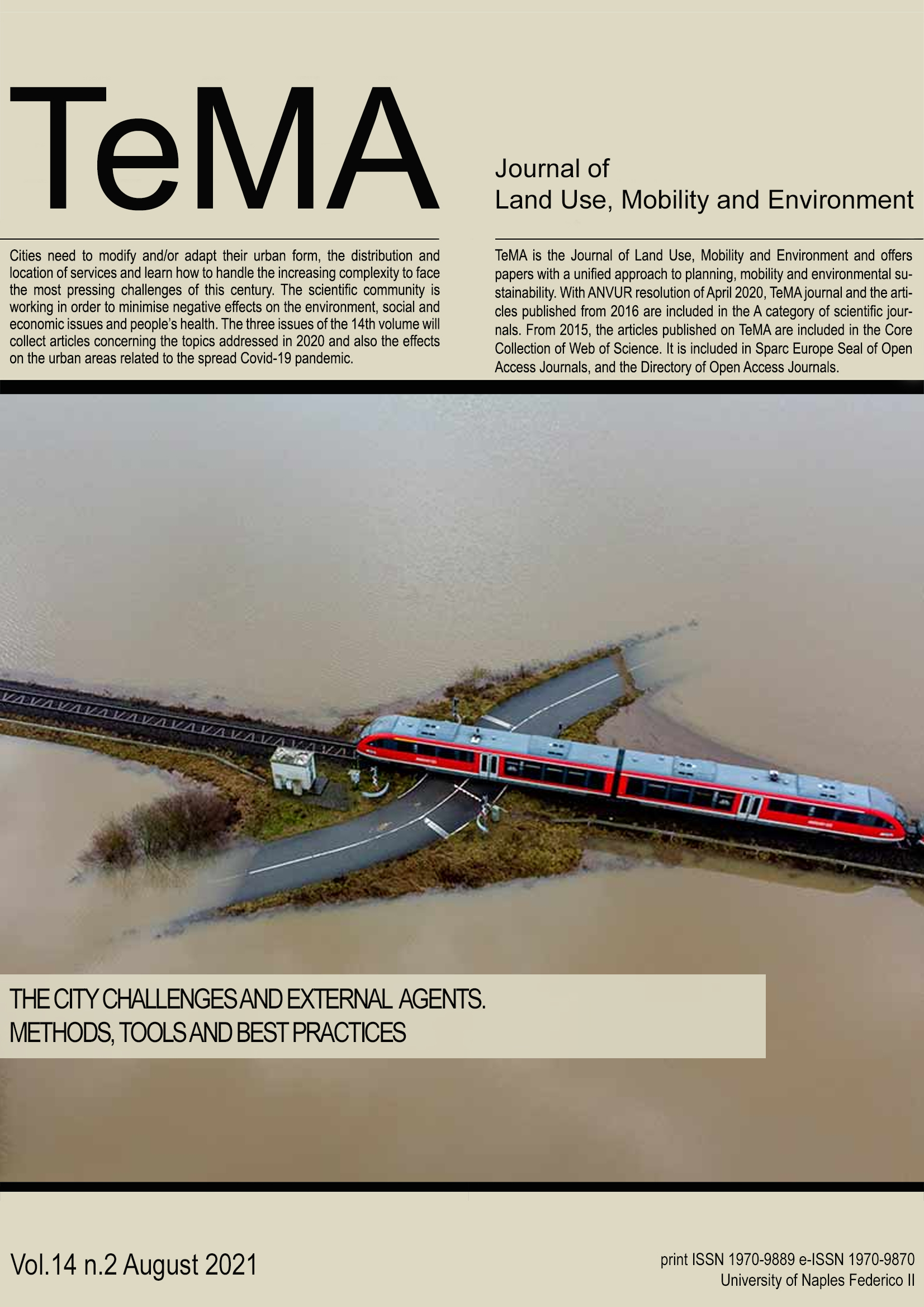Investigation of the effects of urban density on pandemic
Abstract
Decisions regarding land use are amongst the most important decisions of a city planning process, and density arrangement is one of the key parameters for it. The effects of urban density on the Covid-19 infection are evaluated in this study through the sample case of İskenderun district, which was divided into 3 main urban population density regions (high, medium, low). The course of the Covid-19 pandemic was then followed through the number of cases in the period of September-December 2020 for these regions. The case data were obtained from the “HES” application developed by the Ministry of Health of the Republic of Turkey to monitor the spread of the Covid-19 pandemic, and the case density maps recorded in the application for this purpose were digitized through an in-house image processing software. As a result of the examination, it was understood that the rate of increase and the density of cases in regions with high housing density was higher than that of regions with lower densities, with PI (Pandemic Index) values of 173.83 and 39.40 for high and low densities, respectively. The results are indicative that the lack of urban land production and high population concentration, which have become important problems of developing countries and regions due to rapid population growth, are indeed strong factors for the spread of diseases, such as the Covid-19 pandemic.
Downloads
References
Aloi, A., Alonso, B., Benavente, J., Cordera, R., Echániz, E., González, F., Ladisa, C., Lezama-Romanelli, R., López-Parra, Á., & Mazzei, V. (2020). Effects of the COVID-19 lockdown on urban mobility: empirical evidence from the city of Santander (Spain). Sustainability, 12 (9), 3870. https://doi.org/10.3390/su12093870
Alraouf, A. A. (2021). The new normal or the forgotten normal: contesting COVID-19 impact on contemporary architecture and urbanism. Archnet-IJAR: International Journal of Architectural Research. https://doi.org/10.1108/ARCH-10-2020-0249
Cadotte, M. (2020). Early evidence that COVID-19 government policies reduce urban air pollution. https://doi.org/10.31223/osf.io/nhgj3
Carozzi, F., Provenzano, S., Roth, S. (2020). Urban density and COVID-19. Discussion Paper Series. IZA Institute of Labor Economics, 1-29.
Etingoff, K. (2017). Urban Land Use: Community-Based Planning. CRC Press. https://doi.org/10.1201/9781315365794
Fatmi, M. R. (2020). COVID-19 impact on urban mobility. Journal of Urban Management, 9 (3), 270–275. https://doi.org/10.1016/j.jum.2020.08.002
Gehl, J. (2020). Public space and public life during Covid 19. Gehl Institute, Copenhagen.
Gündoğan, G. S., Yildiz, S. G. M. (N.D.). Urbanization and Covid-19 Relationship in Turkey. Theory and Research in Architecture, Planning and Design II, 15.
Krecl, P., Targino, A. C., Oukawa, G. Y., & Junior, R. P. C. (2020). Drop in urban air pollution from COVID-19 pandemic: Policy implications for the megacity of São Paulo. Environmental Pollution (Barking, Essex: 1987), 265, 114883. https://doi.org/10.1016/j.envpol.2020.114883
Sardari Salari, F., & Kiani, A. (2020). Urban Management and COVID-19 Analysis of Salem city of Zabol and the industrial city of Assaluyeh. Journal of Vision Future Cities, 1 (4), 0.
Soucy, J.-P. R., Sturrock, S. L., Berry, I., Daneman, N., MacFadden, D. R., & Brown, K. A. (2020). Estimating the effect of physical distancing on the COVID-19 pandemic using an urban mobility index. MedRxiv. https://doi.org/10.1101/2020.04.05.20054288
Stevens, N. J., Salmon, P. M., Walker, G. H., & Stanton, N. A. (2018). Human Factors in Land Use Planning and Urban Design: Methods, Practical Guidance, and Applications. CRC Press.
Stratoulias, D., & Nuthammachot, N. (2020). Air quality development during the COVID-19 pandemic over a medium-sized urban area in Thailand. Science of The Total Environment, 746, 141320. https://doi.org/10.1016/j.scitotenv.2020.141320
TUĞAÇ, Ç. (2020). The Historical Pandemics and the COVID-19 Pandemic from the Perspective of Urban Sustainability and Urban Resilience. Van Yüzüncü Yıl University The Journal of Social Sciences Institute, Outbreak Diseases Special Issue, 259–292.
TÜRKOĞLU, H. (2020). COVID-19 Sonrası Kent ve Kent Planlama. Türkiye Sağlıklı Kentler Birliği.
WHO. (1997). Twenty steps for developing a Healthy Cities project. Healthy City Project.
Kanyepe, J., Tukuta, M., Chirisa, I. (2021). Urban Land-use and Traffic Congestion: Mapping the Interaction. Journal of Contemporary Urban Affairs. 5 (1), 77-84. https://doi.org/10.25034/ijcua.2021.v5n2-6
Oshrierh, R., and Valipour, E. 2019. The Role of Urban Density and Morphology in the Air Pollution of Tehran Metropolitan. Journal of Contemporary Urban Affairs. 3 (1), 38-43. https://doi.org/10.25034/ijcua.2018.4680
Beattie, L., and Haarhoff, E. 2018. Urban Growth, Liveability and Quality Urban Design: Questions about the efficacy of urban planning systems in Auckland, New Zealand. Journal of Contemporary Urban Affairs. 2 (2), 12-23. https://doi.org/10.25034/ijcua.2018.3667
‘COVID-19 and Healthy Cities’ (2021). Retrieved from: https://www.euro.who.int/en/health-topics/environment-and-health/urban-health/who-european-healthy-cities-network/the-who-european-healthy-cities-network-a-response-to-the-Covid-19-pandemic-close-to-the-people [accessed: 19 July 2021]
Google Maps (2021). Retrieved from: https://www.google.com/maps/@36.5653158,36.1439381,13z/data=!5m1!1e1 [accessed: 15 July 2021]
UN (2020) COVID-19 in an Urban World | United Nations. United Nations. Retrieved from: https://www.un.org/en/coronavirus/Covid-19-urban-world [accessed: 19 July 2021]
Tira M. (2021). Planning to prevent disasters. Tema. Journal of Land Use, Mobility and Environment, 191-202. http://dx.doi.org/10.6092/1970-9870/7890
Copyright (c) 2021 TeMA - Journal of Land Use, Mobility and Environment

This work is licensed under a Creative Commons Attribution 4.0 International License.
Authors who publish in this journal agree to the following:
1. Authors retain the rights to their work and give in to the journal the right of first publication of the work simultaneously licensed under a Creative Commons License - Attribution that allows others to share the work indicating the authorship and the initial publication in this journal.
2. Authors can adhere to other agreements of non-exclusive license for the distribution of the published version of the work (ex. To deposit it in an institutional repository or to publish it in a monography), provided to indicate that the document was first published in this journal.
3. Authors can distribute their work online (ex. In institutional repositories or in their website) prior to and during the submission process, as it can lead to productive exchanges and it can increase the quotations of the published work (See The Effect of Open Access)

